You are using an out of date browser. It may not display this or other websites correctly.
You should upgrade or use an alternative browser.
You should upgrade or use an alternative browser.
Battle for Arnhem.... (5 Viewers)
- Thread starter panda1gen
- Start date
Wolfgang_UK
Staff Sergeant
- Joined
- Dec 5, 2009
- Messages
- 836
You ment Major Payne? In case you are into the coalition war period, there is of cause Major Schill, Commander of a Freikorps „Die Schillschen Jäger“ . Phonetic identical with General Chill but 120 years earlier. Written with an S (chill) it is a rather common Name, but does not stand for anything either - unless you start digging deeper that is.
Sure that just made your day ….
Regards
Wolfgang
Sure that just made your day ….
Regards
Wolfgang
panda1gen
Colonel
- Joined
- Jul 29, 2005
- Messages
- 8,162
1035th Fusilier Regiment was the other component of Kampfgruppe Jungwirth.
In the immediate wake of the Allied landings in Normandy and the 1944 Soviet summer offensive, the Wehrmacht was in dire need of manpower. As a result, the 27th mobilization wave created five new but ad-hoc infantry divisions, mainly consisting of troops on furlough. The 59th Infantry Division was one of these, and initially formed at the Gross-Born Troop Maneuver Area on June 26, 1944.
It saw action on the Western Front, but had a serious equipment and training shortage due to its quick formation. The division was initially assigned to the 15th Army and posted to the Dunkirk area around August 20, 1944. After the 15th Army was cut off along the English Channel coast by the capture of Antwerp by Allied forces behind them, the Germans left behind garrisons in the coastal ports as "fortresses" to be defended to the end.
On August 30, the division contributed Lieutenant Colonel Ludwig Schroeder to command the Calais fortress, and possibly additional troops, as it and the rest of 15th Army withdrew from the coast.
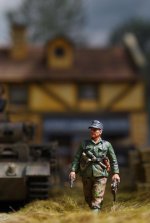
The division was evacuated across the Scheldt estuary, via Walcheren to Brabant in the Netherlands. On September 17 1944, the division was located around Boxtel and its strength was reported at approximately 1,000 infantry, with some artillery and anti-tank support. During this retreat, it was fortuitously situated close to the initial airborne landings of Operation Market Garden and immediately committed to defend against it.
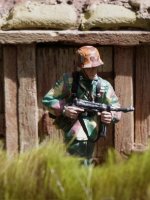


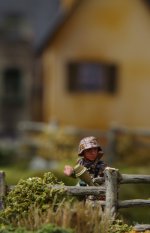
The division mainly fought the American 101st Airborne Division in the area immediately north of Eindhoven between Son and Shijndel.
(After Market-Garden, the Division continued to oppose Allied advances in this area, including assaults by the XII British Corps from the South through October and the early part of November. After this, the Division was withdrawn, refitted and was back in action around Aachen by December 1944. In February 1945 the division was stationed on The Rhine. It fought in the Battle of the Ruhr and was in the Ruhr pocket when it surrendered to the Allies in April 1945.)
Ref: Wikipedia.
In the immediate wake of the Allied landings in Normandy and the 1944 Soviet summer offensive, the Wehrmacht was in dire need of manpower. As a result, the 27th mobilization wave created five new but ad-hoc infantry divisions, mainly consisting of troops on furlough. The 59th Infantry Division was one of these, and initially formed at the Gross-Born Troop Maneuver Area on June 26, 1944.
It saw action on the Western Front, but had a serious equipment and training shortage due to its quick formation. The division was initially assigned to the 15th Army and posted to the Dunkirk area around August 20, 1944. After the 15th Army was cut off along the English Channel coast by the capture of Antwerp by Allied forces behind them, the Germans left behind garrisons in the coastal ports as "fortresses" to be defended to the end.
On August 30, the division contributed Lieutenant Colonel Ludwig Schroeder to command the Calais fortress, and possibly additional troops, as it and the rest of 15th Army withdrew from the coast.

The division was evacuated across the Scheldt estuary, via Walcheren to Brabant in the Netherlands. On September 17 1944, the division was located around Boxtel and its strength was reported at approximately 1,000 infantry, with some artillery and anti-tank support. During this retreat, it was fortuitously situated close to the initial airborne landings of Operation Market Garden and immediately committed to defend against it.




The division mainly fought the American 101st Airborne Division in the area immediately north of Eindhoven between Son and Shijndel.
(After Market-Garden, the Division continued to oppose Allied advances in this area, including assaults by the XII British Corps from the South through October and the early part of November. After this, the Division was withdrawn, refitted and was back in action around Aachen by December 1944. In February 1945 the division was stationed on The Rhine. It fought in the Battle of the Ruhr and was in the Ruhr pocket when it surrendered to the Allies in April 1945.)
Ref: Wikipedia.
Kevin, I like most of Damon Wayan's movies, he made several back in the non pc era.Matt,
Thanks for that quote, I did not know it so had to look it up - not seen that film.
Wolfgang,
It does seem a bit quieter but hopefully more people will actively join in.
All the best,
Kevin
Wolfgang, that's a cool name as well. Yes I did mean 'Major Payne', and I assume you meant 'meant' not 'ment'. BTW, my neighbour (Fritz/Fred) is from Bremen, Germany. He's 88 years old, he told me he played Football/Soccer in Germany in a major team when he was young, he's still fit for his age.You ment Major Payne? In case you are into the coalition war period, there is of cause Major Schill, Commander of a Freikorps „Die Schillschen Jäger“ . Phonetic identical with General Chill but 120 years earlier. Written with an S (chill) it is a rather common Name, but does not stand for anything either - unless you start digging deeper that is.
Sure that just made your day ….
Regards
Wolfgang
And I'll check out Major Schill.
panda1gen
Colonel
- Joined
- Jul 29, 2005
- Messages
- 8,162
The Battle for the Eerde Sand Dunes – 25th September 1944
Shortly before 10.00 hours von der Heydte’s Fallschirmjäger approached Company C, 1/501 PIR’s outposts, which had been positioned in the sand dunes to the northwest of the village.

The divisional historian recalled:
‘The outpost platoon came rushing back with word that the town was about to be attacked by five tanks [assault guns] and two hundred infantry coming down the road from Schijndel. By the time Lieutenant Colonel Kinnard got the report, the enemy was in the dunes, looking down the throats of his men.’
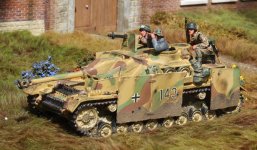
Colonel Johnson, back at 501 PIR’s Regimental Headquarters, dispatched A Squadron 44/RTR (with their nine remaining Shermans) towards Eerde with orders to check the German advance.

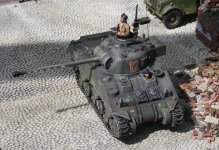
At the same time, Lieutenant Howard climbed the Church steeple in order to act as a spotter for effective artillery fire (despite the attention it was receiving from the enemy tanks). Allied tanks and artillery could now support the determined paratroopers, so the German advance was halted in the sand dunes.
British XXX Corps guns in support ....
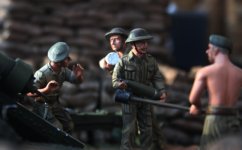
Shortly before 10.00 hours von der Heydte’s Fallschirmjäger approached Company C, 1/501 PIR’s outposts, which had been positioned in the sand dunes to the northwest of the village.

The divisional historian recalled:
‘The outpost platoon came rushing back with word that the town was about to be attacked by five tanks [assault guns] and two hundred infantry coming down the road from Schijndel. By the time Lieutenant Colonel Kinnard got the report, the enemy was in the dunes, looking down the throats of his men.’

Colonel Johnson, back at 501 PIR’s Regimental Headquarters, dispatched A Squadron 44/RTR (with their nine remaining Shermans) towards Eerde with orders to check the German advance.


At the same time, Lieutenant Howard climbed the Church steeple in order to act as a spotter for effective artillery fire (despite the attention it was receiving from the enemy tanks). Allied tanks and artillery could now support the determined paratroopers, so the German advance was halted in the sand dunes.
British XXX Corps guns in support ....

panda1gen
Colonel
- Joined
- Jul 29, 2005
- Messages
- 8,162
As a result, the Germans attempted to manoeuvre around Eerde,
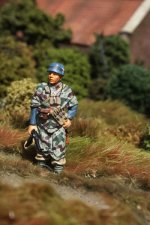
.... where in defence, 44/RTR lost a further three precious Shermans.

To the north, Company B and neighbouring Company I (3/501 PIR) had created overlapping arcs of fire and this firepower was sufficient to prevent the Germans from advancing along the railway line.
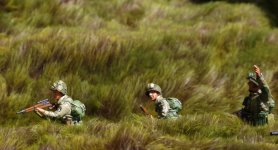
Company C was to form a fire support base from its central position on the crest of the dunes. On the southern flank of the dunes, Company A moved up from their original positions immediately south of the village. Company A was to advance from south-east to north-west, to clear the sand dunes.
‘Captain Stach of A Company was given a section of light machine guns, a mortar observer and a prayer.’
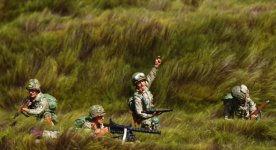
H Hour was 12.15. An artillery barrage preceded the attack, fired the by guns of the 101st, reinforced by those of XXX Corps.
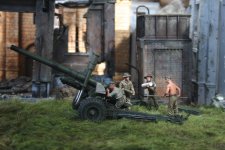

.... where in defence, 44/RTR lost a further three precious Shermans.

To the north, Company B and neighbouring Company I (3/501 PIR) had created overlapping arcs of fire and this firepower was sufficient to prevent the Germans from advancing along the railway line.

Company C was to form a fire support base from its central position on the crest of the dunes. On the southern flank of the dunes, Company A moved up from their original positions immediately south of the village. Company A was to advance from south-east to north-west, to clear the sand dunes.
‘Captain Stach of A Company was given a section of light machine guns, a mortar observer and a prayer.’

H Hour was 12.15. An artillery barrage preceded the attack, fired the by guns of the 101st, reinforced by those of XXX Corps.

panda1gen
Colonel
- Joined
- Jul 29, 2005
- Messages
- 8,162
On their left flank, 1st Platoon’s second in command, Lieutenant Murphy, led a squad forward to secure a wooded area. At first this advance went well, but when they emerged into an open area, they came under heavy fire.
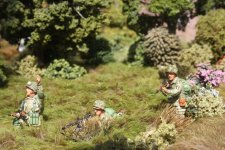
As the squad dived for cover, Private Belffer ran to a fire position on the left flank. From that position, he shot at the Germans, undaunted by the volume of German fire that became concentrated on him. He virtually won the fire-fight on his own.
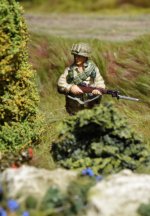
The rest of 1st Platoon moved up, and the platoon’s other machine guns joined Private Belffer to form a fire support group. The riflemen prepared to attack. Meanwhile, the Germans sheltered from the hail of lead, keeping their heads down.
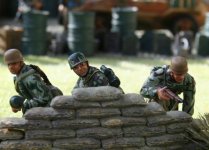
Seizing the moment, Lieutenant Mosier yelled,
‘Lets go!’
The paratroopers ran across hundred metres of open area, ignoring exploding mortar rounds and machine gun fire. As the highly trained and aggressive American paratroopers closed in, some Germans broke and ran.
Working in pairs, the paratroopers flushed the remaining Fallschirmjäger out of their shallow trenches, which had been hastily dug in the sandy soil.
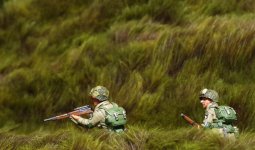
The ensuing fight had all the frenzy and brutality to be expected when two military élites meet head on. Lieutenant Murphy recalled:
‘What we did in those moments we could scarcely remember afterwards because we had no time to think. It was courage such as I have never imagined possible, almost foolish courage, and I doubt if any group of men could have held their ground against us’.
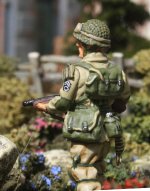
At the end of the battle, there were fifteen dead Fallschirmjäger along with seven wounded prisoners.

As the squad dived for cover, Private Belffer ran to a fire position on the left flank. From that position, he shot at the Germans, undaunted by the volume of German fire that became concentrated on him. He virtually won the fire-fight on his own.

The rest of 1st Platoon moved up, and the platoon’s other machine guns joined Private Belffer to form a fire support group. The riflemen prepared to attack. Meanwhile, the Germans sheltered from the hail of lead, keeping their heads down.

Seizing the moment, Lieutenant Mosier yelled,
‘Lets go!’
The paratroopers ran across hundred metres of open area, ignoring exploding mortar rounds and machine gun fire. As the highly trained and aggressive American paratroopers closed in, some Germans broke and ran.
Working in pairs, the paratroopers flushed the remaining Fallschirmjäger out of their shallow trenches, which had been hastily dug in the sandy soil.

The ensuing fight had all the frenzy and brutality to be expected when two military élites meet head on. Lieutenant Murphy recalled:
‘What we did in those moments we could scarcely remember afterwards because we had no time to think. It was courage such as I have never imagined possible, almost foolish courage, and I doubt if any group of men could have held their ground against us’.

At the end of the battle, there were fifteen dead Fallschirmjäger along with seven wounded prisoners.
panda1gen
Colonel
- Joined
- Jul 29, 2005
- Messages
- 8,162
1st Platoon remained in position to guard Company A’s left flank. 2nd Platoon’s mission was to advance through the centre of the sand dunes. Here, they also came under small-arms, machine gun and mortar fire.
Defenders and attackers exchanged grenades over the scrub covered dunes, as they fought from dune to dune.

The pattern of American covering fire from the Platoon’s 60mm mortar and machine guns, supporting a wild rush and a bitter close quarter fight, was repeated until the large central dune was reached. Here the Americans came to a halt.
The Germans had made use of an open area, one hundred yards wide, to produce a kill zone with a wall of fire.
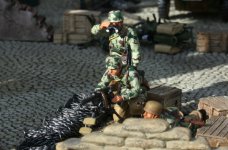
The situation for 2nd Platoon, whose leaders had been killed, was made worse when a Jagdpanther opened fire on them and the Fallschirmjäger counterattacked.
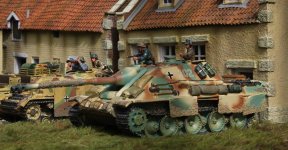
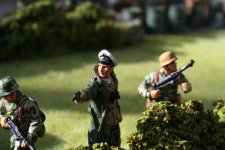
It is entirely to 2nd Platoon’s credit that they stood their ground and beat off the enemy. Unable to resume their attack however, they found that they had occupied excellent fire positions, from where they were able to pin down the Germans. They could also act as cut-offs for Lieutenant Mier’s 3rd Platoon, who were to come up from reserve and attack on the company’s right flank driving the Germans from the large dune into 2nd Platoon’s fire.
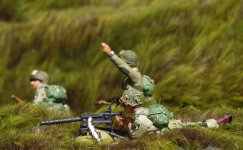
Defenders and attackers exchanged grenades over the scrub covered dunes, as they fought from dune to dune.

The pattern of American covering fire from the Platoon’s 60mm mortar and machine guns, supporting a wild rush and a bitter close quarter fight, was repeated until the large central dune was reached. Here the Americans came to a halt.
The Germans had made use of an open area, one hundred yards wide, to produce a kill zone with a wall of fire.

The situation for 2nd Platoon, whose leaders had been killed, was made worse when a Jagdpanther opened fire on them and the Fallschirmjäger counterattacked.


It is entirely to 2nd Platoon’s credit that they stood their ground and beat off the enemy. Unable to resume their attack however, they found that they had occupied excellent fire positions, from where they were able to pin down the Germans. They could also act as cut-offs for Lieutenant Mier’s 3rd Platoon, who were to come up from reserve and attack on the company’s right flank driving the Germans from the large dune into 2nd Platoon’s fire.

villagehorse
Lieutenant General
- Joined
- Feb 5, 2010
- Messages
- 16,683
That Jagdpanther is a formidable beast and great that it fits into the story line Kevin. Robin.
villagehorse
Lieutenant General
- Joined
- Feb 5, 2010
- Messages
- 16,683
Which reminds me, Andy Neilson was visiting my man cave yesterday and remarked how my Hougoumont buildings could be used in WW11 scenes and I agreed and immediately thought of you. Robin.
panda1gen
Colonel
- Joined
- Jul 29, 2005
- Messages
- 8,162
I agree Robin - powerful gun, thick, sloped armour and decent speed - good job so few were made. One can only admire the fortitude of these US Paras.That Jagdpanther is a formidable beast and great that it fits into the story line Kevin. Robin.
I like the K&C model too.
All the best,
Kevin
panda1gen
Colonel
- Joined
- Jul 29, 2005
- Messages
- 8,162
panda1gen
Colonel
- Joined
- Jul 29, 2005
- Messages
- 8,162
Ref: Battleground Europe - Operation Market Garden, Hell’s Highway - By Tim Saunders
559/Panzerjäger’s Battalion’s Attack
Ref: https://www.pegasusarchive.org/arnhem/order_lxxxviii.htm
According to the reference above, Panzerjäger Abteilung 559, at this time was probably equipped with 4 x Jagdpanther,
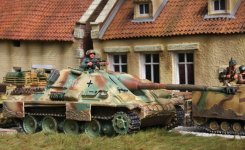
and possibly 12 x StuG III (assigned to Kampfgruppe Walther during the battle),
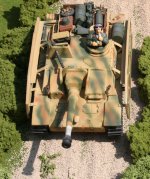
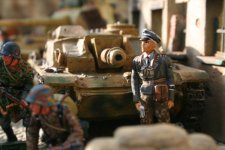
plus support vehicles.

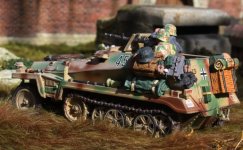
References:
https://blog.sturmpanzer.com/jagdpanther-organization/
https://community.battlefront.com/topic/31117-german-heavy-panzerj%C3%A4ger-battalions/
https://forum.axishistory.com/viewtopic.php?t=80098
559/Panzerjäger’s Battalion’s Attack
Ref: https://www.pegasusarchive.org/arnhem/order_lxxxviii.htm
According to the reference above, Panzerjäger Abteilung 559, at this time was probably equipped with 4 x Jagdpanther,

and possibly 12 x StuG III (assigned to Kampfgruppe Walther during the battle),


plus support vehicles.


References:
https://blog.sturmpanzer.com/jagdpanther-organization/
https://community.battlefront.com/topic/31117-german-heavy-panzerj%C3%A4ger-battalions/
https://forum.axishistory.com/viewtopic.php?t=80098
Louis Badolato
Lieutenant General
- Joined
- Apr 25, 2005
- Messages
- 18,442
Kevin,
Love the shots from the book photo shoot ... I especially love the mahogany Stug III, one of my all time favorite K&C models!
Love the shots from the book photo shoot ... I especially love the mahogany Stug III, one of my all time favorite K&C models!
panda1gen
Colonel
- Joined
- Jul 29, 2005
- Messages
- 8,162
Sand dunes are not good tank country and, consequently, the assault guns of 559 Panzerjäger Battalion now sought other avenues of approach to the Veghel Bridges.
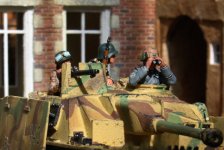
To the north of Eerde, 1 and 3/501 PIR presented a solid front protecting the direct route to their objectives. Therefore, they took the open approach to the south of Eerde and its dunes. In doing so, they destroyed a patrol of three British Shermans sent up from the route north to see what was happening around Eerde.

Colonel Kershaw described the scene as the 559 panzer-jäger closed in on Hell’s Highway:
‘On the main road, allied drivers frantically baled out of trucks ....

.... as the Panzerjäger began machine-gunning and shelling the highway.
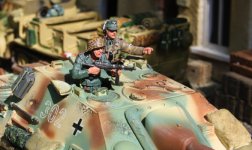
The ammunition vehicles disintegrated into flaming, spitting pyres as drivers scurried for cover, throwing themselves into roadside ditches. A troop of three British tanks churning down the main road was brewed up, one tank after the other. Within minutes, huge writhing palls of black oily smoke were boiling up into the sky.
Traffic to the north jerked to a halt as this awesome spectacle of destruction began to blot out the skies before them. Vulnerable trucks began to jam up nose to tail…’
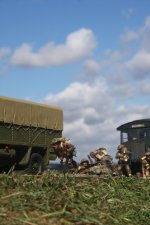

To the north of Eerde, 1 and 3/501 PIR presented a solid front protecting the direct route to their objectives. Therefore, they took the open approach to the south of Eerde and its dunes. In doing so, they destroyed a patrol of three British Shermans sent up from the route north to see what was happening around Eerde.

Colonel Kershaw described the scene as the 559 panzer-jäger closed in on Hell’s Highway:
‘On the main road, allied drivers frantically baled out of trucks ....

.... as the Panzerjäger began machine-gunning and shelling the highway.

The ammunition vehicles disintegrated into flaming, spitting pyres as drivers scurried for cover, throwing themselves into roadside ditches. A troop of three British tanks churning down the main road was brewed up, one tank after the other. Within minutes, huge writhing palls of black oily smoke were boiling up into the sky.
Traffic to the north jerked to a halt as this awesome spectacle of destruction began to blot out the skies before them. Vulnerable trucks began to jam up nose to tail…’

panda1gen
Colonel
- Joined
- Jul 29, 2005
- Messages
- 8,162
That a cut had been made was the kind of positive news that General Chill was under pressure to deliver to General Reinhard’s LXXXVII Corps. To the north of the Eerde Sand Dunes, Chill was able to report, at 15.00 hours that his troops were,
‘within 700 yards of the railway bridge’.
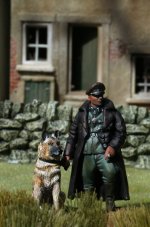
However, what he did not report was that a well organized battalion of American paratroopers was standing in his way ....
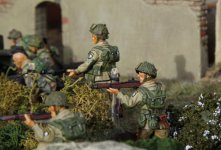
and that they were showing no signs of being overcome by von der Hydte’s 6 Fallschirmjäger Regiment.
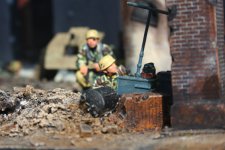
More accurately, he reported that,
‘So far the Corridor had only been cut by fire south of Eerde’.
Two lone assault guns had closed Hell’s Highway in the area south of Veghel and by mid-afternoon on 24 September,
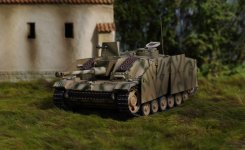
the vulnerability of the Corridor, only a road’s width wide in places, was plain for all to see.
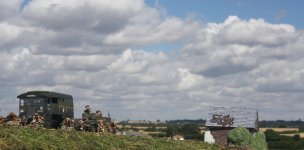
‘within 700 yards of the railway bridge’.

However, what he did not report was that a well organized battalion of American paratroopers was standing in his way ....

and that they were showing no signs of being overcome by von der Hydte’s 6 Fallschirmjäger Regiment.

More accurately, he reported that,
‘So far the Corridor had only been cut by fire south of Eerde’.
Two lone assault guns had closed Hell’s Highway in the area south of Veghel and by mid-afternoon on 24 September,

the vulnerability of the Corridor, only a road’s width wide in places, was plain for all to see.

panda1gen
Colonel
- Joined
- Jul 29, 2005
- Messages
- 8,162
panda1gen
Colonel
- Joined
- Jul 29, 2005
- Messages
- 8,162
Ref: Battleground Europe - Operation Market Garden
Hell’s Highway - By Tim Saunders
Evening 24 September 1944 – The Cut at Koevering
Meanwhile, twenty-five miles to the north, XXX Corps was preparing to mount a battalion operation to cross the Rhine with 4/Dorset.
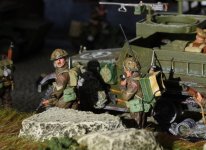
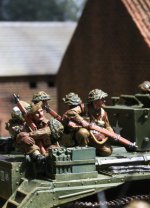

In the event of failure, contingency orders had been issued for the evacuation of the British Airborne from the Oosterbeek Perimeter, so the cut in XXX Corps’ supply route at Koevering would subsequently be a contributory factor in General Horrocks deciding to seek General Dempsey’s confirmation that Operation BERLIN, the evacuation, was to be carried out the following night.
Major Hans Jungwirth’s Kampfgruppe avoided contact with the enemy by striking in a south-easterly direction from Schijndel towards Hell’s Highway. At 18.00 peering through his field glasses,
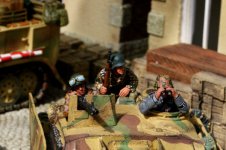
.... he saw the column of Allied vehicles halted, nose to tail, on the road north, the route in front of him having been blocked by the fire of the assault guns.

Allied vehicles parked nose to tail, presented an excellent target and resulted in a spectacular conflagration. The flickering light from burning trucks illuminated the night and ammunition ‘cooked-off’ and shot into the sky.
According to the author of XXX Corps’ History:
‘As was only to be expected the enemy’s efforts resulted in the capture of a number of vehicles and men.
One man, Driver Ferguson, of 536 Company RASC, which was moving up to Nijmegen at the time, managed to elude capture and spent three days and nights in the loft of a house where the enemy set up headquarters. Indeed, one night Driver Ferguson had the company of some German soldiers in the same loft, but managed to hide himself by burrowing into a pile of wheat sacks.’
Hell’s Highway - By Tim Saunders
Evening 24 September 1944 – The Cut at Koevering
Meanwhile, twenty-five miles to the north, XXX Corps was preparing to mount a battalion operation to cross the Rhine with 4/Dorset.



In the event of failure, contingency orders had been issued for the evacuation of the British Airborne from the Oosterbeek Perimeter, so the cut in XXX Corps’ supply route at Koevering would subsequently be a contributory factor in General Horrocks deciding to seek General Dempsey’s confirmation that Operation BERLIN, the evacuation, was to be carried out the following night.
Major Hans Jungwirth’s Kampfgruppe avoided contact with the enemy by striking in a south-easterly direction from Schijndel towards Hell’s Highway. At 18.00 peering through his field glasses,

.... he saw the column of Allied vehicles halted, nose to tail, on the road north, the route in front of him having been blocked by the fire of the assault guns.

Allied vehicles parked nose to tail, presented an excellent target and resulted in a spectacular conflagration. The flickering light from burning trucks illuminated the night and ammunition ‘cooked-off’ and shot into the sky.
According to the author of XXX Corps’ History:
‘As was only to be expected the enemy’s efforts resulted in the capture of a number of vehicles and men.
One man, Driver Ferguson, of 536 Company RASC, which was moving up to Nijmegen at the time, managed to elude capture and spent three days and nights in the loft of a house where the enemy set up headquarters. Indeed, one night Driver Ferguson had the company of some German soldiers in the same loft, but managed to hide himself by burrowing into a pile of wheat sacks.’
panda1gen
Colonel
- Joined
- Jul 29, 2005
- Messages
- 8,162
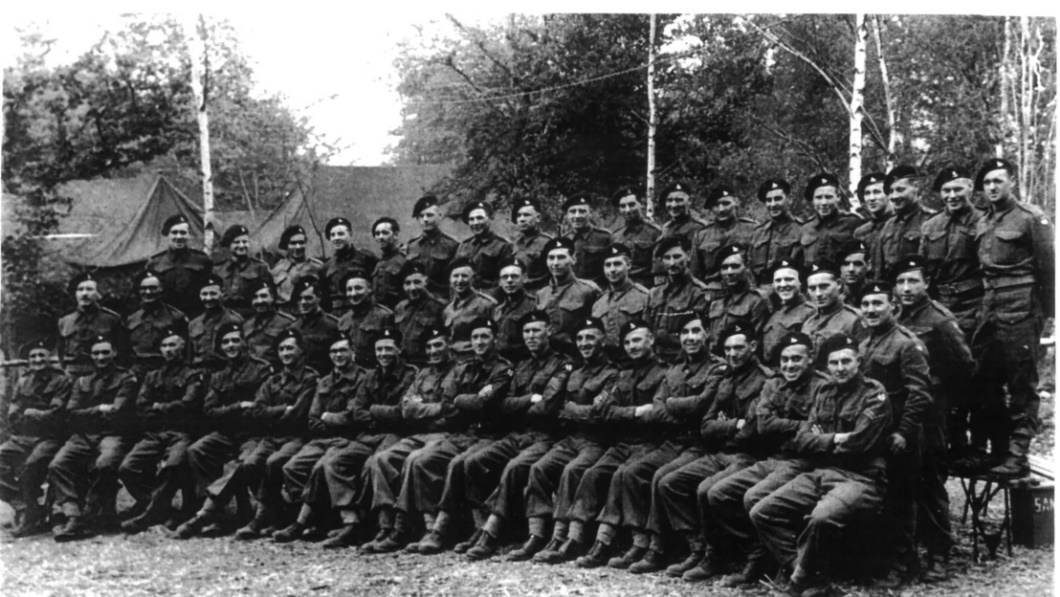
70 YEARS AGO - The Battle for Veghel - 1 - Eindhoven News
NEWS - A true story as told by Dorothy Ramser, daughter of Sgt M. I. Dickson about three British gunners during The Battle for Veghel also known as 'Operation - 70 YEARS AGO - The Battle for Veghel - 1
 eindhovennews.com
eindhovennews.com
70 YEARS AGO – The Battle for Veghel – 1
By Editor - 15 September 2014
A true story as told by Dorothy Ramser, daughter of Sgt M. I. Dickson about three British gunners during The Battle for Veghel also known as ‘Operation Market Garden’.
One in a series of 7 articles, this one about C Troop, 342 Battery, 86th Hertfordshire Yeomanry Field Regiment Royal Artillery – Veghel, 24-25th September 1944.
The Regiment was in Veghel from the 21st – 30th September 1944. The soldiers in this story: Gunner Denys Hunter of X Tank, Gunner Joe Cattini, Ammunition Driver, Sgt Michael Dickson of C Gun.
The 24th of September 1944 in Veghel, was warm and sunny. It was a bad day for the gunners of 342 Battery, being shelled at regular intervals by enemy artillery, but returning it with just as much ferocity. They were firing in support of attacks made by 44th Royal Tank Regiment and 101st US Airborne Division, with the gun position south of Veghel – St. Oedenrode, 1000 yards short of the Veghel Bridge over the Zuid-Willemsvaart Canal.
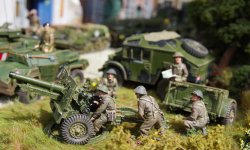
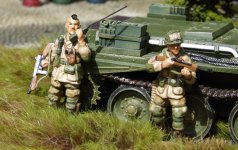
As night time fell, although they were still answering fire calls from 101st US Airborne, the men of 342 Battery made a sickening discovery. The infantry of 231 Brigade, of the 50th Northumbrian Division, had moved north to a new position, leaving the gunners with no support in an area that was infested with Panzer Grenadiers and enemy tanks. What is more their position had been known to the enemy all afternoon.

21-year-old Gunner, Joe Cattini, on one of his many hazardous ammunition deliveries, explained to Dorothy 70 years later that he had seen large shell holes, shockingly peppering the gun area of 342 Battery, which bore witness to the ferocity and accuracy of the German artillery.

Delivering vital supplies via the aptly named ‘Hell’s Highway’ was a dangerous business. That day the Regiments War Diary records that a large number of ammunition and petrol lorries had been brewed up.
Thankfully, Joe got through unscathed. When the enemy succeeded in cutting the road, trucks were jammed bumper to bumper – the road being a perfect target for lethal German 88’s, as it was higher than the surrounding landscape, so as Joe remembered, any vehicle was a perfect target for enemy guns.
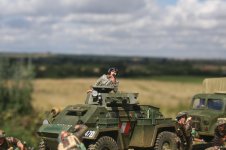
He told Dorothy that ammunition trucks would explode in a ball of flames – if the driver was lucky, he might just have time to leap to safety from the driver’s seat, before being himself engulfed in flames, or blown to bits. The wreckage of burnt out vehicles littered the route, as an unwelcome reminder to drivers like Joe Cattini, carrying vital supplies.
The men of 342 Battery knew it was going to be a very long and anxious night, with the enemy never far away and often surrounding them. Knowing that two days before, in Eerde, the Germans had been murdering civilians in cold blood probably didn’t help to ease their minds.
See continuation of story on www.EindhovenNews.nl
Attachments
Users who are viewing this thread
Total: 4 (members: 0, guests: 4)




